SEO (or Search Engine Optimization) is central to your website’s visibility. It is an important way of communicating with Google and other search engines to prove the relevance of your site for users and their search queries.
In this article, we will explore the importance of SEO for websites and pages. We will look at some of the most important aspects of SEO, why SEO is important for your website, and what role SEO plays in your digital marketing strategy. Here’s what we’re going to go over:
What Is SEO and Organic Search?
SEO communicates the importance and relevance of their websites and pages to Google. Through SEO, your content becomes more likely to rank highly in the SERPs and appear to users first when they search for relevant keywords.
Organic search refers to search results that aren’t paid for. Instead of being organized by Google’s paid ad guidelines (which includes CPC, ad relevance, and many other factors), organic search results are organized by its search engine algorithm.
Organic search and SEO go hand-in-hand. SEO brings in organic traffic, which is central to succeeding digitally.
Why Are SEO and Organic Search Important?
The importance of SEO is not something to overlook. Search engines employ specific algorithms and KPIs to direct online traffic to one site or another. Let’s take a closer look at this with an example.
With Semrush’s Traffic Analytics Tool, you can compare your website traffic to your competitors’. We’ve taken two sites that sell shoes. As you can see, finding out where the most traffic comes from for these big brands is actually pretty easy.
All you do is input the domains:

And then look at the results:
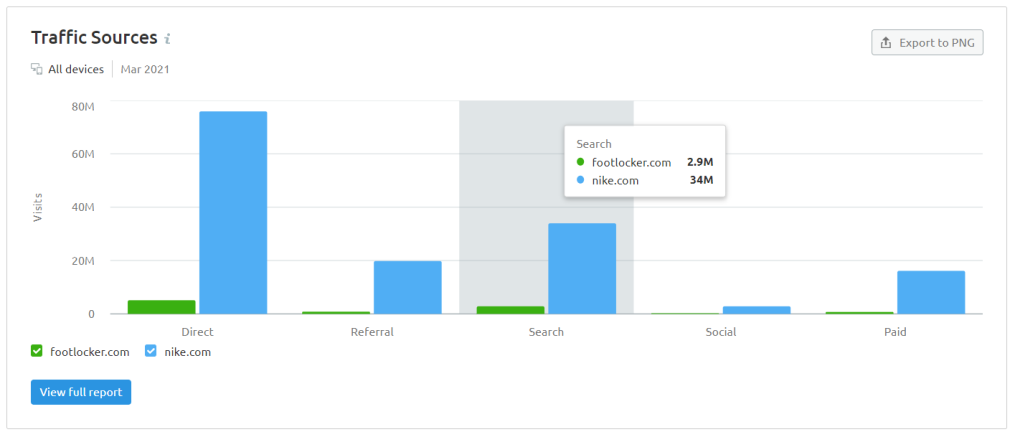
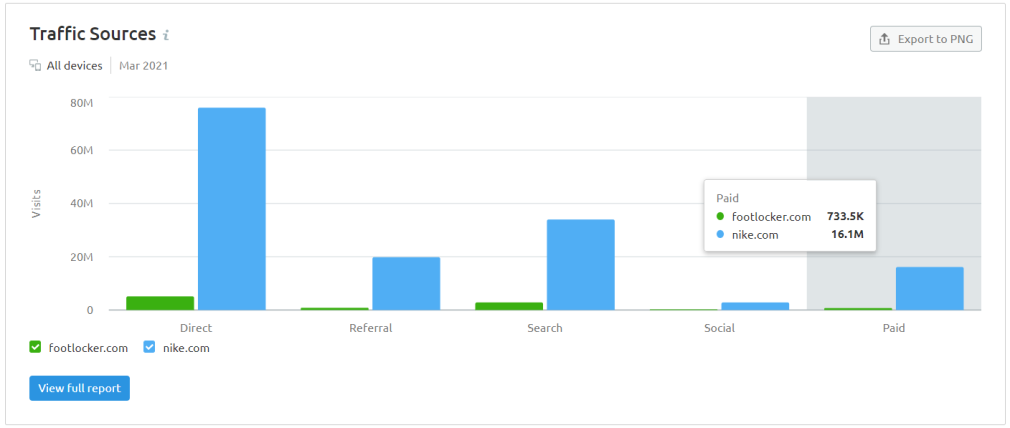
You can see by looking at these two large brands that organic search is a vital part of their strategy.
There are numerous benefits to having a strong organic search strategy. And from a business perspective, you’re getting key insights into your audience. Here are just a few of the reasons SEO is important:
- It’s low-cost
- It delivers great ROI
- It provides actionable data
- It nurtures leads through the marketing funnel
- It boosts credibility
- It attracts relevant users
But how can you recognize paid and organic search results?
Users can immediately see which results are paid for and which are organic by the ‘ads’ icon:
Paid results appear first on the SERPs, with organic search results appearing immediately below them. Though, different SERPs may appear for different users.
Paid and organic can, at times, be targeting different audiences at different parts of the buying funnel. Those looking to make a purchase or get something quickly are more likely to click a paid ad, while organic users are nurtured throughout the funnel — from entrance to purchase (or whatever the end of your funnel may be.)
When you optimize your site, you give search engines the best information possible to allow them to index and display your sites and pages on the SERPs. The importance of SEO can never be underestimated when creating content; you must optimize it correctly.
Organic Search and Digital Marketing
It’s important to remember that your content provides a service. If you think of a search engine as the marketplace for that service, then ranking highly on their first page is a great way to market what you’ve got on offer.
Organic search marketing can take a bit of time to show results, and SEO is a process that evolves with your site, meaning that you need to stay on top of it to keep benefiting.
However, it’s worth the effort. All you have to do is make sure that you nurture your traffic through the marketing funnel to achieve this revenue. And to do that, you need to practice SEO and improve your SEO techniques.
How Can I Improve My Site’s SEO?
SEO isn’t something to feel daunted by. The most important aspects of SEO can be easy to change and modify within your site, especially when you’ve got the right tools.
Let’s go through some of the most important aspects of SEO and how you can strategize with them to improve your organic search rankings.
User Intent
The first step towards improving your SEO and gaining visibility online is understanding the intent of your users. Why are they using the search engine? What are they looking for?
User intent can be shown in a few ways, such as:
- Informational
- Transactional
- Navigational
Informational searches are when a user is looking for information. For example, if they search ‘what are green shoes?’.

If a user is looking for a certain brand, this is a navigational search.

If a user wants to buy something, this is a transactional search. In this case, they might search ‘green shoes for sale.’

Google is pretty good at identifying user intent by inspecting how keywords are connected within the search phrase. It will figure out what a user wants from the search and decide how to rank the results accordingly: the most pertinent results for that user intent will be on top.
Thankfully, we have a Semrush tool for helping you understand who your audience is and what they want. In the Semrush Traffic Analytics Tool, our Audience Insights Report shows you where you have the greatest audience share and helps you understand the interests of your potential users.
By examining the results, you can quantify your potential reach and understand your users’ brand preferences, seeing which websites you share an audience with and where your audience is unique to you.

In the Overview section, you’ll see the percentage of visits from desktop devices compared to mobile. This can help you decide how important it is that your site is optimized for different devices.
In the example below, more people accessed the site through a mobile device. Therefore, it would be important that the mobile site for this domain is attractive and easy to navigate.
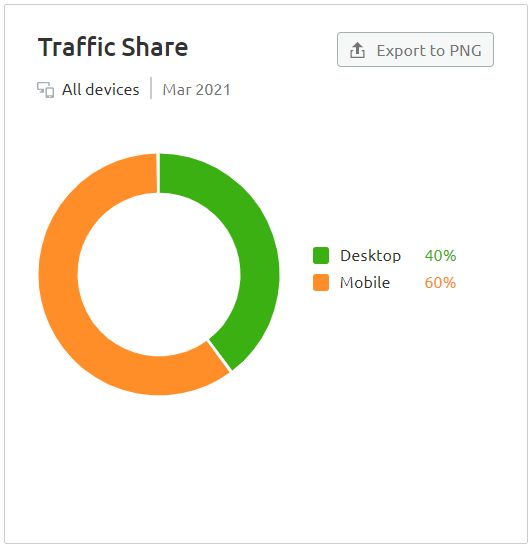
Pro tip: If you run a site that gets international business, be sure to check out which country your visitors are searching from, too. If you notice that you get significantly more traffic from one market, it may be worth adjusting your site content to cater for them:

Keywords
Another important aspect of SEO is keywords. SEO keywords are the words and phrases that you use in your content and that users search for in search engines. In our above example, the keyword was ‘green shoes.’
Search engines check sites and pages for how well the content matches user search terms, its intent, and a whole host of other factors. When you use the same keywords in your content as your target audience is searching for, you signal to search engines that you’ll give people what they want.
For inspiration and strategizing, the Semrush Keyword Magic Tool can help you figure out what potential users want and how best to target them. All you have to do is input your keyword:
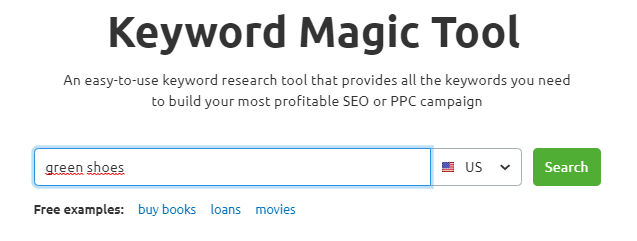
And check out the results:
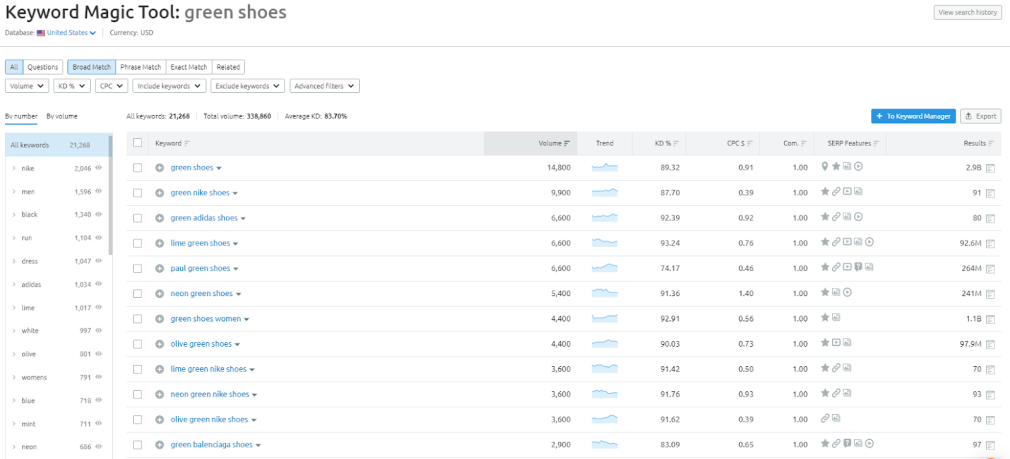
Find out the keywords people use alongside ‘green shoes’ in their search queries and check out the most searched for questions:

The questions feature is particularly useful if you’re writing informational content. It tells you what most people ask search engines with long-tail keywords and practical questions that can serve as inspiration to structure your informative, in-depth, and niche articles.
Now you know how to find essential keywords for your site pages, and you’re one step closer to great SEO.
Links
For good SEO, you need to be aware of links and link building. Link building is a process in digital marketing which aims to generate as many incoming links for your site as possible.
Having lots of links from well-reputed sources is great for SEO because they act as votes of confidence. Google recognizes that if your peers trust you, you can be trusted by users. There is a direct correlation between your links and your site traffic.
But how do you get good backlinks? We’ve got just the tool that can help. The Semrush Link Building Tool collects opportunities for link building and helps you build and run an outreach campaign to acquire more links.
All you have to do is input your keywords and your competitors’ domains:

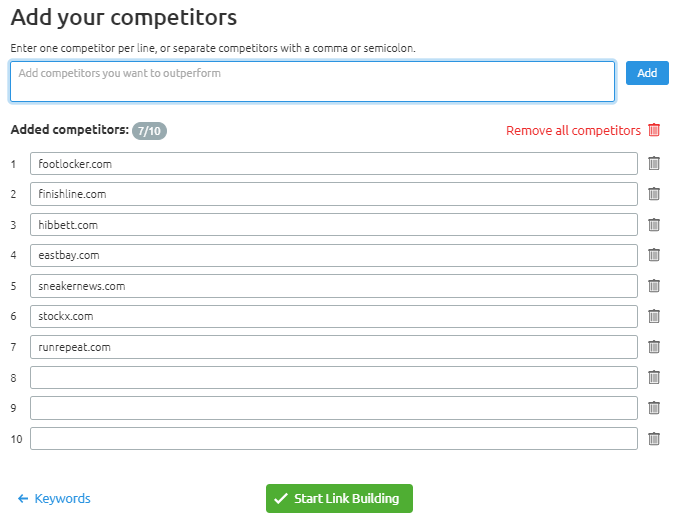
And the Link Building Tool will give you an overview of useful statistics.
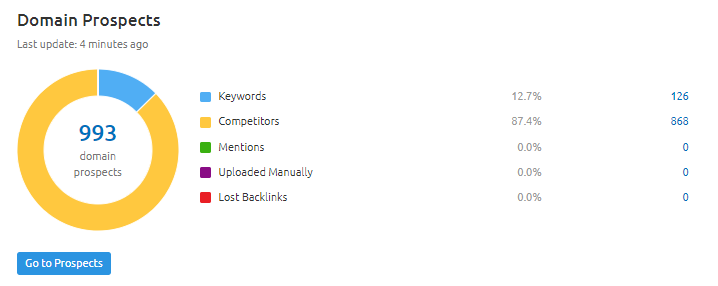

As well as a list of domains you could reach out to for new links and advice on actions to take, such as email outreach or results tracking.


Once you’ve set up your campaign, you’ll start your quest to build your backlink profile in hopes of getting additional votes of confidence and get recognized by Google as an authoritative site.
Avoiding Bad Backlinks
So, links are good — but are they always healthy? Yes, a long list of links may represent a vote of confidence and can flag to Google that you’re trustworthy. However, if you’re linked to from poor, spammy sites, it can do more harm than good. So how do you avoid toxic backlinks?
Using the Semrush Backlink Audit Tool is a great place to start. It will analyze any suspicious links and create a disavow file to send to Google.
The tool will give you a complete overview of your backlink status, so you’ll see exactly what’s going on:

And it will do an audit for you, suggesting how to manage your most toxic backlinks:

Once you’ve discovered where your links are coming from, you should start to send out disavow files with all the links from toxic or potentially toxic domains and show to Google you want to differentiate your trustworthy website from those untrustworthy sites.
Pro tip: Some sites may have lower Authority Scores and provide backlinks to your site. However, depending on your site’s niche, that may not be all bad. It’s important to know the context of what vertical you’re working with and what to expect.
Tracking Your Traffic
Once you’ve followed the above recommendations, you might want to take another look at the big picture of your website’s online presence. But it can be tricky to find and analyze all the statistics and how they’ve changed: your organic and paid search results, your use of display advertising, your backlinks… the list goes on.
That’s why we have a Domain Overview to help you understand where you stand. It will give you a quick overview of your search engine presence, an analysis of your top keywords, and some great competitive research reports.
Check the overview for a quick look at your stats:

You can also explore the details of your traffic sources as well as all ranking positions for your chosen organic keywords:
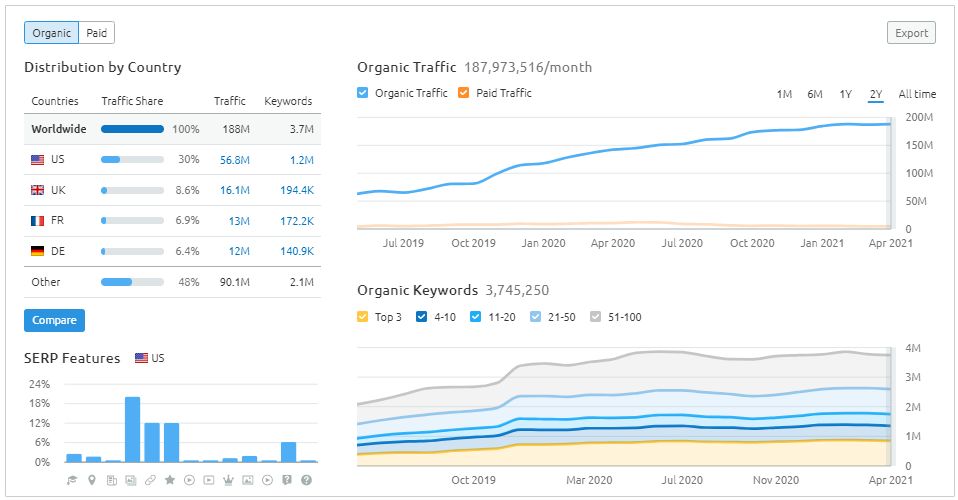
This is also the perfect opportunity to check out your competition and see how they’re working:
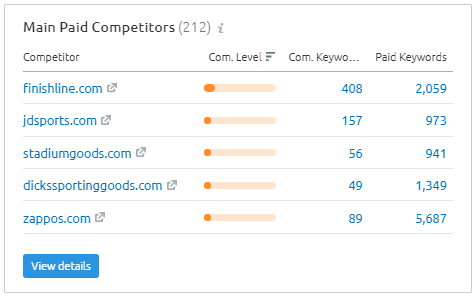
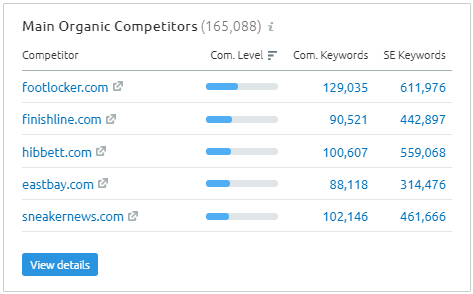
The Domain Overview is the perfect place to reconvene and assess your SEO situation, see your progress, and plan to advance further in the world of organic search.
Crafting Content for Users (with SEO in Mind)
Now you know all the tips, tricks, and tools, are you ready to get started? Good!
If you want an SEO strategy that’s carefully hand-crafted for your industry, we’ve got you covered. All you need is your target keywords and your target country to create your own SEO Content Template.
Input your keyword, and Semrush will analyze the top-ranking content on Google before providing you with in-depth recommendations on how you can create the best SEO content.
Here is a step-by-step to help you organize your a piece of content:
- Input your keyword.
- Check out your top Google rivals.
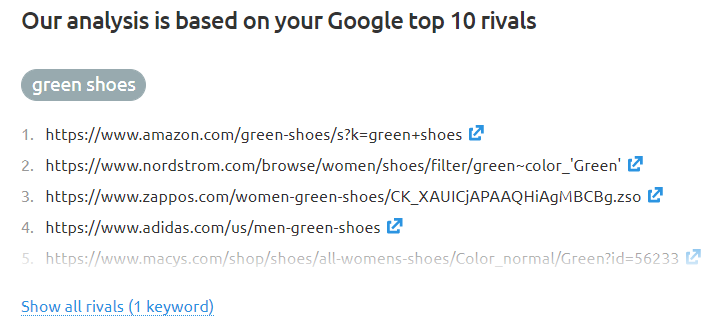
- Look at Semrush’s recommendations and consider how to act on them.

- Get a closer look at how your keywords are used elsewhere on other sites.
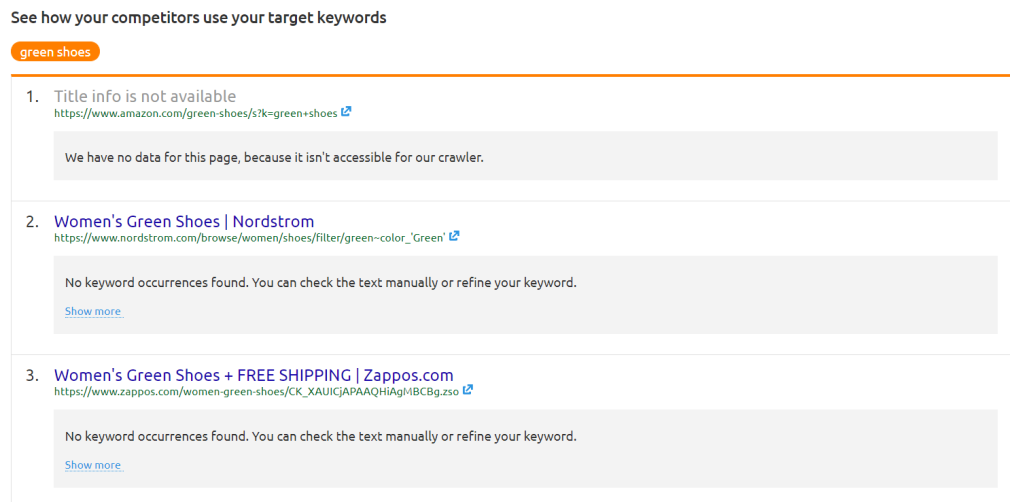
- Finally, take a glance at the basic, step-by-step recommendations from Semrush.

These recommendations allow you to better understand the SERP and what’s performing for your desired query. By knowing your audience, their potential intent, and what’s ranking on the SERPs, you’re in a better position to create content that’s both an excellent resource for your readers and/or customers. And search engines will be more likely to place your content in more favorable positions.
SEO for Your Website
So, although optimizing your site for search engines might sound like just another task on the to-do list for building your website, you can trust us when we tell you that it really pays off.
To help ensure that you’re optimizing your site to the best of your ability, it’s important to work with the right tools.
Semrush has a whole suite of tools to help you from the initial planning stages through the implementation and maintenance of your site to ensure your SEO strategy is firing on all cylinders. Be sure to look at some of the tools mentioned and get to work on your SEO.
Source: Semrush


